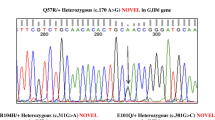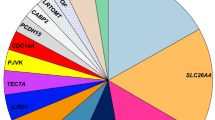Abstract
Autosomal recessive deafness type 1A (DFNB1A) caused by mutations in the GJB2 gene (Cx26) is the main cause of nonsyndromic hearing impairment in many populations worldwide. It is considered that widespread prevalence of DFNB1A can be due to the long tradition of intermarriages between deaf people (assortative marriages) combined with their increased social adaptation and genetic fitness after widespread introduction of sign language. For the first time, the data on mating structure and reproduction of deaf people living in Yakutia (Eastern Siberia, Russia) are presented in comparison with contribution of the GJB2 gene mutations to the etiology of hearing impairment. The relative fertility of deaf people compared to their hearing siblings is 0.78 (mean number of children 1.76 ± 0.10 and 2.24 ± 0.09 to deaf and their hearing siblings, respectively, p = 0.0018). The rate of assortative marriages among deaf people is 77.1% (81 of 105 marriages). Biallelic mutations in the GJB2 gene were found in 42.2% (43 of 102) of examined deaf people, which corresponded to diagnosis DFNB1A for these patients. A comparison of deaf marital partners by GJB2 status revealed a proportion of noncomplementary marriages (24%) in which hearing loss in both partners was caused by the presence of biallelic GJB2 gene mutations resulting in the birth of only deaf children in such couples. Thus, the set of obtained data including a relatively high genetic fitness (expressed as relative fertility) of deaf people in Yakutia in combination with a high rate of assortative marriages among them and high incidence of DFNB1A indicates a possible weakening of selection against such trait as “deafness” and a possible increase in the frequency of GJB2 mutant alleles in subsequent generations.
Similar content being viewed by others
References
Van Camp, G. and Smith, R.J.H., Hereditary Hearing Loss. http://hereditaryhearingloss.org. Accessed June 2, 2017.
Chan, D.K. and Chang, K.W., GJB2-associated hearing loss: systematic review of worldwide prevalence, genotype, and auditory phenotype, Laryngoscope, 2014, vol. 124, no. 2, pp. 34–53. doi 10.1002/lary. 24332
Stenson, P.D., Mort, M., Ball, E.V., et al., The Human Gene Mutation Database: towards a comprehensive repository of inherited mutation data for medical research, genetic diagnosis and next-generation sequencing studies, Hum. Genet., 2017. doi 10.1007/s00439-017-1779-6
Groce, N.E., Everyone Here Spoke Sign Language: Hereditary Deafness on Martha’s Vineyard, Cambridge, MA: Harvard Univ. Press, 1985.
Scott, D.A., Carmi, R., Elbedour, K., et al., Nonsyndromic autosomal recessive deafness is linked to the DFNB1 locus in a large inbred Bedouin family from Israel, Am. J. Hum. Genet., 1995, vol. 57, no. 4, pp. 965–968.
Winata, S., Arhya, I.N., Moeljopawiro, S., et al., Congenital non-syndromal autosomal recessive deafness in Bengkala, an isolated Balinese village, J. Med. Genet., 1995, vol. 32, no. 5, pp. 336–343.
Van Laer, L., Coucke, P., Mueller, R.F., et al., A common founder for the 35delG GJB2 gene mutation in connexin 26 hearing impairment, J. Med. Genet., 2001, vol. 38, no. 8, pp. 515–518. doi 10.1136/jmg.38.8.515
RamShankar, M., Girirajan, S., Dagan, O., et al., Contribution of connexin26 (GJB2) mutations and founder effect to non-syndromic hearing loss in India, J. Med. Genet., 2003, vol. 40, no. 5. doi 10.1136/jmg.40.5.e68
Ben Arab, S., Masmoudi, S., Beltaief, N., et al., Consanguinity and endogamy in Northern Tunisia and its impact on non-syndromic deafness, Genet. Epidemiol., 2004, vol. 27, no. 1, pp. 74–79. doi 10.1002/gepi.10321
Lezirovitz, K., Pardono, E., de Mello Auricchio, M.T., et al., Unexpected genetic heterogeneity in a large consanguineous Brazilian pedigree presenting deafness, Eur. J. Hum. Genet., 2008, vol. 16, no. 1, pp. 89–96. doi 10.1038/sj.ejhg.5201917
Sirmaci, A., Öztürkmen-Akay, H., Erbek, S., et al., A founder TMIE mutation is a frequent cause of hearing loss in southeastern Anatolia, Clin. Genet., 2009, vol. 75, no. 6, pp. 562–567. doi 10.1111/j.1399-0004.2009.01183.x
Yan, D., Park, H.J., Ouyang, X.M., et al., Evidence of a founder effect for the 235delC mutation of GJB2 (connexin 26) in East Asians, Hum. Genet., 2003, vol. 114, no. 1, pp. 44–50. doi 10.1007/s00439-003-1018-1
Barashkov, N.A., Dzhemileva, L.U., Fedorova, S.A., et al., Autosomal recessive deafness 1A (DFNB1A) in Yakut population isolate in Eastern Siberia: extensive accumulation of the splice site mutation IVS1+1G>A in GJB2 gene as a result of founder effect, J. Hum. Genet., 2011, vol. 56, no. 9, pp. 631–639. doi 10.1038/jhg.2011.72
Nance, W.E., Liu, X.Z., and Pandya, A., Relation between choice of partner and high frequency of connexin-26 deafness, Lancet, 2000, vol. 356, no. 9228, pp. 500–501. doi 10.1016/S0140-6736(00)02565-4
Nance, W.E. and Kearsey, M.J., Relevance of connexin deafness (DFNB1) to human evolution, Am. J. Hum. Genet., 2004, vol. 74, no. 6, pp. 1081–1087. doi 10.1086/420979
Bender, R.F., The Conquest of Deafness, Cleveland, 1970.
Posukh, O.L., Bady-Khoo, M.S., Zytsar’, M.V., et al., The impact of the sociodemographic structure of deaf people communities on the prevalence of hereditary hearing loss, Russ. J. Genet.: Appl. Res., 2016, vol. 6, no. 8, pp. 854–863. https://doi.org/10.1134/S2079059716070108.
Arnos, K.S., Welch, K.O., Tekin, M., et al., A comparative analysis of the genetic epidemiology of deafness in the United States in two sets of pedigrees collected more than a century apart, Am. J. Hum. Genet., 2008, vol. 83, no. 2, pp. 200–207. doi 10.1016/j.ajhg.2008. 07.001
Blanton, S.H., Nance, W.E., Norris, V.W., et al., Fitness among individuals with early childhood deafness: studies in alumni families from Gallaudet University, Ann. Hum. Genet., 2010, vol. 74, no. 1, pp. 27–33. doi 10.1111/j.1469-1809.2009.00553.x
Schein, J. and Delk, M., The Deaf Population of the United States, Silver Spring, MD: National Association of the Deaf, 1974.
Hu, D.N., Qiu, W.Q., Wu, B.T., et al., Prevalence and genetic aspects of deaf mutism in Shanghai, J. Med. Genet., 1987, vol. 24, no. 10, pp. 589–592. doi 10.1136/jmg.24.10.589
Liu, X., Xu, L., Zhang, S., and Xu, Y., Epidemiological and genetic studies of congenital profound deafness in the general population of Sichuan, China, Am. J. Med. Genet., 1994, vol. 53, no. 2, pp. 192–195. doi 10.1002/ajmg.1320530214
Carlsson, P.I., Danermark, B., and Borg, E., Marital status and birthrate of deaf people in two Swedish counties: the impact of social environment in terms of deaf community, Am. Ann. Deaf., 2004—2005, vol. 149, no. 5, pp. 415–420. doi 10.1353/aad.2005.0010
Tekin, M., Xia, X.-J., Erdenetungalag, R., et al., GJB2 mutations in Mongolia: complex alleles, low frequency, and reduced fitness of the deaf, Ann. Hum. Genet., 2010, vol. 74, no. 2, pp. 155–164. doi 10.1111/j.1469-1809.2010.00564.x
Barashkov, N.A., Teryutin, F.M., Pshennikova, V.G., et al., Age-related hearing impairment (ARHI) associated with GJB2 single mutation IVS1+1G>A in the Yakut population isolate in Eastern Siberia, PLoS One, 2014, vol. 9, no. 6. doi 10.1371/journal.pone.0100848
Barashkov, N.A., Pshennikova, V.G., Posukh, O.L., et al., Spectrum and frequency of the GJB2 gene pathogenic variants in a large cohort of patients with hearing impairment living in a Subarctic region of Russia (the Sakha Republic), PLoS One, 2016, vol. 11, no. 5. doi 10.1371/journal.pone.0156300
Stevenson, A.C. and Cheeseman, E.A., Hereditary deaf mutism, with particular reference to Northern Ireland, Ann. Hum. Genet., 1956, vol. 20, no. 3, pp. 177–231.
Chaabani, H., Ben Arab, S., and Chebbi, K., Genetic heterogeneity study of non-syndromic autosomal recessive sensorineural deafness within the Tunisian population, Ann. Genet., 1995, vol. 38, no. 3, pp. 158–161.
Author information
Authors and Affiliations
Corresponding author
Additional information
Original Russian Text © G.P. Romanov, N.A. Barashkov, F.M. Teryutin, S.A. Lashin, A.V. Solovyev, V.G. Pshennikova, A.A. Bondar, I.V. Morozov, N.N. Sazonov, M.I. Tomsky, L.U. Dzhemileva, E.K. Khusnutdinova, O.L. Posukh, S.A. Fedorova, 2018, published in Genetika, 2018, Vol. 54, No. 5.
Rights and permissions
About this article
Cite this article
Romanov, G.P., Barashkov, N.A., Teryutin, F.M. et al. Marital Structure, Genetic Fitness, and the GJB2 Gene Mutations among Deaf People in Yakutia (Eastern Siberia, Russia). Russ J Genet 54, 554–561 (2018). https://doi.org/10.1134/S1022795418050071
Received:
Accepted:
Published:
Issue Date:
DOI: https://doi.org/10.1134/S1022795418050071




